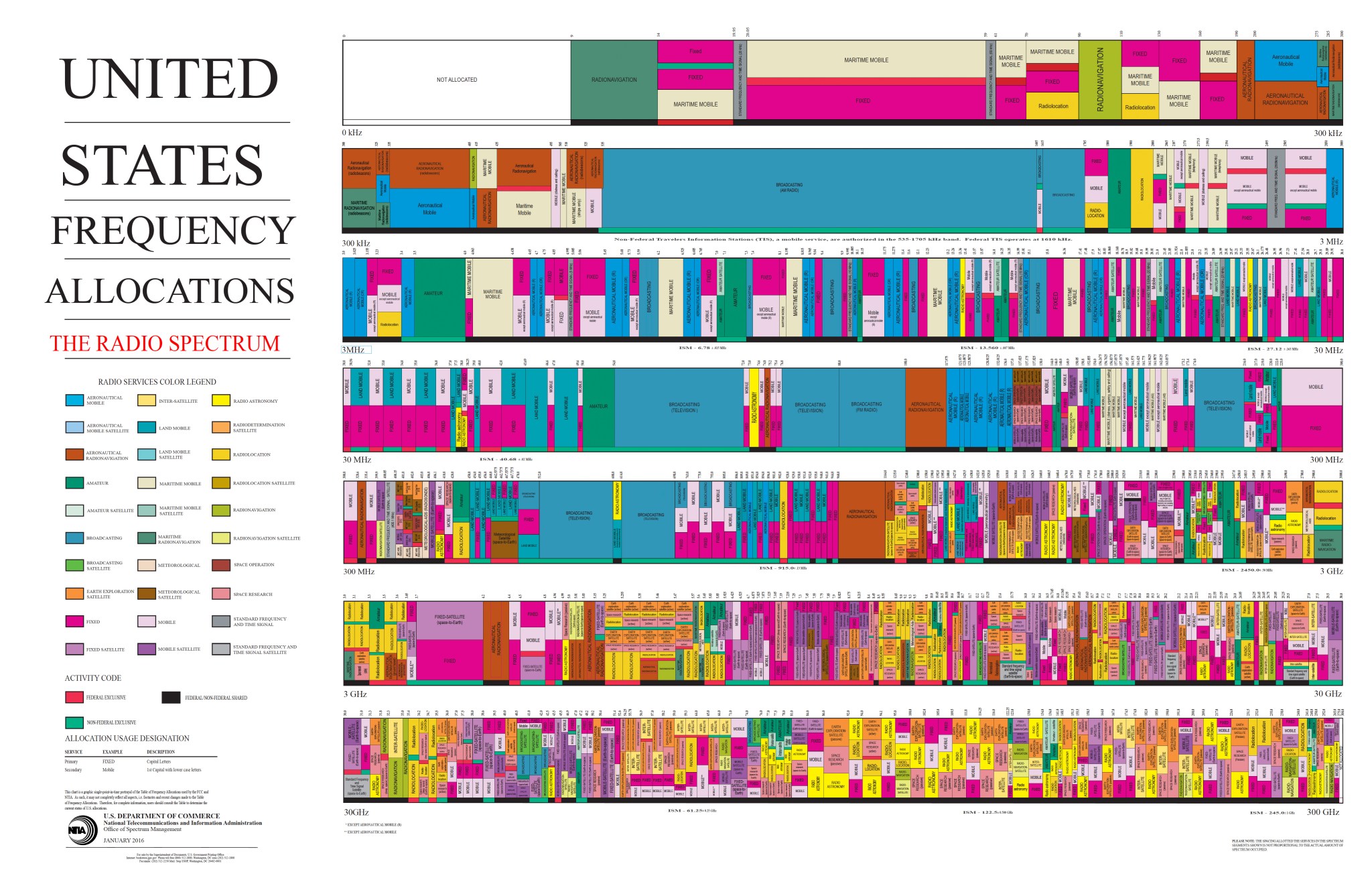Spectrum Management is cooperative effort. Space Communications and Navigation (SCaN) performs the spectrum management tasks for all of NASA’s missions encompassing human and autonomous spaceflight missions.
SCaN’s Spectrum Management team participates on behalf of NASA at both the national and international levels.
SCaN’s Spectrum Management Team works to:
- Support ground and space network functionality
- Regulate NASA’s use of electromagnetic spectrum.
- Grow NASA’s space communication and navigation capabilities.
- Develop Spectrum policy for the agency
National Spectrum Management
At the national level, the Space Communications and Navigation (SCaN) Program participates on behalf of NASA as a representative member of the National Telecommunication and Information Administration (NTIA) and the Federal Communications Commission (FCC).
NATIONAL TELECOMMUNICATIONS AND INFORMATION ADMINISTRATION (NTIA)
The National Telecommunications and Information Administration (NTIA) is the President’s principal advisor on telecommunications and information policy issues, and in this role it frequently works with other Executive Branch agencies to develop and present the Administration’s position on these issues. The NTIA was established within the U.S. Department of Commerce in 1978 by an Executive Order. Subsequently, Congress codified its functions in the National Telecommunications and Information Administration Organization Act. The National Telecommunications and Information Administration Organization Act provides that NTIA shall assign frequencies and approve the spectrum needs of new systems for use by the federal government. Federal government users must obtain these frequency assignments before they can operate transmitters. The Administrator of NTIA is the ultimate authority in all spectrum management decisions for the federal government; however, frequency assignment decisions can be appealed to the Director of the Office of Management and Budget.
FEDERAL COMMUNICATIONS COMMISSION (FCC)
The Federal Communications Commission (FCC) is an independent Federal regulatory agency responsible directly to Congress. Established by the Communications Act of 1934, it is charged with regulating interstate and international communications by radio, television, wire, satellite, and cable. Its jurisdiction covers the 50 states and territories, the District of Columbia, and U.S. Possessions. The FCC is directed by five commissioners appointed by the President and confirmed by the Senate for five-year terms, except when filling an unexpired term. The President designates one commissioner to serve as chairman. As the chief executive officer of the Commission, the chairman delegates management and administrative responsibility to the Managing Director. Certain other functions are delegated to staff units and bureaus and to committees of commissioners. The commissioners hold regular open agenda meetings as well as special hearings. They also may act between meetings by “circulation”, a procedure by which a document is submitted to each commissioner individually for consideration and official action.
The NTIA and the FCC manage their respective constituents’ uses of the spectrum; however, both must keep in mind the overall best interests of the public. The two spectrum managers have divided the usable radio spectrum (0-300 GHz) into about 800 frequency bands, and have allocated these bands to 34 radio services (e.g., fixed, radio navigation, mobile, broadcasting, and various satellite services). The allocation plan continues to change to meet evolving domestic and international spectrum needs.
International Spectrum Management
The electromagnetic spectrum needs to be shared by all of the world’s citizens, nations from all over the world must meet and come up with standards and regulations for the use of the spectrum. The United Nations’ International Telecommunications Union (ITU) is the foremost recognized international body doing just that.
INTERNATIONAL TELECOMMUNICATIONS UNION (ITU)
- SCaN’s International Spectrum Program Manager participates in activities of the International Telecommunications Union (ITU) to:
- Ensure Agency compliance with international rules and regulations pertaining to the use of radio frequencies,
- Ensure timely dissemination of technical and regulatory changes to the Field Installation Spectrum Managers for evaluation and implementation,
- Provide planning and implementation of actions required to obtain new allocations or enhanced radio regulations, and
- Provide input documentation and analyses necessary to obtain System Registration at the ITU for those systems that operate internationally.
SPACE FREQUENCY COORDINATION GROUP (SFCG)
The Space Frequency Coordination Group (SFCG) was established in order to provide a forum for the solution of frequency management problems encountered by member space organizations through which global space systems spectrum resources are husbanded.
The SFCG is primarily concerned with the effective use of the radio frequency bands that are allocated by the Radio Regulations of the ITU to the Space Research, Space Operations, Earth Exploration Satellite, and Meteorological Satellite services. Within the formal framework of the international Radio Regulations, there is the need for informal agreement among participating space agencies concerning assignment of specific frequencies, and related technical issues. The result of SFCG meetings is the adoption of resolutions and recommendations which express technical and administrative agreements. These agreements may be used by space agencies to make best use of allocated bands and to avoid interference.
The Spectrum Policy and Planning Division within Space Communications and Navigation (SCaN) represents NASA at the Space Frequency Coordination Group.
WORLD RADIOCOMMUNICATION CONFERENCE (WRC)
The World Radiocommunication Conference (WRC) of the International Telecommunication Union Radiocommunication Sector (ITU-R) is held every three to four years for member states with vested interested in radio-frequency spectrum. Since 1993, the purpose of the conference has been to review and revise the international treaty called the Radio Regulations, which governs the use of radio-frequency spectrum, frequency assignments, allotment plans, geostationary satellite orbits and non-geostationary satellite orbits.
Agenda items are established at the preceding WRC and the Conference Preparatory Meeting (CPM) decides which ITU-R Study Group will be responsible for specific agenda items. The ITU Council, which is the governing body of the ITU, decides on the venue two years prior to a WRC. These milestones give member states some time to formulate, negotiate, and decide their position on each of the items before the next conference.
The Spectrum Policy and Planning Division within Space Communications and Navigation (SCaN) represents NASA on all spectrum-related items. SCaN brings NASA’s position to the United States delegation, which is comprised of other US federal agencies, non-governmental entities and commercial/private companies. The delegation meets regularly and refines its position. Key members of the US delegation also attend preparatory meetings with other countries and other regional bodies to share their preliminary thoughts on agenda items before the WRC.
Spectrum Regulation
Society’s increasing use of radio-based technologies, and the opportunities for development that these technologies provide, highlight the importance of the radio spectrum. The spectrum is used for all forms of wireless communication including: cellular telephone, radio and television broadcasting, GPS position locating, aeronautical and maritime radio navigation, and satellite command and control. Technological progress has continually opened doors to a variety of new radio applications that have spurred interest in, and demand for spectrum. The amount of available spectrum is a fixed resource. Increased demand requires that the radio spectrum be used efficiently and this means that effective spectrum management processes must be implemented. Spectrum management is the oversight of radio frequency spectrum use. The goal is to prevent users from harmful interference while allowing optimum use of the spectrum. There are four phases of spectrum management:
SPECTRUM ALLOCATION
Spectrum allocation is a planning function which involves the designation of portions of the frequency spectrum to specified uses in accordance with international agreements, technical characteristics and potential use of different parts of the spectrum, and national priorities and policies. Spectrum allocation is a distribution of frequencies to radio services. An allocation designates the use of a given frequency band for use by one or more radio communication services. National and international tables of frequency allocations contain lists of these frequency band designations. Currently, the U.S. Table of Frequency Allocations covers the radio spectrum between 9 kHz and 300 GHz.
SPECTRUM AUTHORIZATION
Spectrum authorization is a licensing function which involves granting access for use under specified conditions to the spectrum resource by various types of radio communication stations. An assignment is a distribution of a frequency or frequencies to a given radio station in order to permit use of the radio frequency or frequencies under specified conditions. This may involve assigning specific frequencies to users, assigning certain frequency bands or sub-bands to users who may be able to transfer such spectrum rights to others, or it may mean authorizing the use of specific categories of equipment (unlicensed devices).
Spectrum authorization activities include analyzing requirements for proposed frequencies in accordance with national frequency allocations and any applicable technical standards in order to select the most appropriate frequencies for radio communication systems. These activities also include actions to coordinate proposed assignments with existing assignments and to protect radio communication systems from harmful interference. An operator is assigned a frequency or set of frequencies in order to provide communications services, and this assignment of frequencies is done in a way to avoid harmful interference with other users of the spectrum. Spectrum authorization strategies ensure proper radio spectrum use, facilitate reuse, and achieve spectrum efficiency.
SPECTRUM ENGINEERING
Spectrum engineering is a regulatory function which involves the development of electromagnetic compatibility standards (technical standards) for equipment that emits or is susceptible to radio frequencies and the development of procedural rules for use of radio equipment. There are technical standards which describe procedures for how spectrum is used – spectrum operating standards; and standards which state conditions of apparatus compliance – radio equipment standards. Spectrum operating standards state the minimal technical requirements for the efficient use of a specified frequency band or bands. Equipment standards involve certification of radio equipment such as transmitters, receivers and antennas in order to determine compliance with radio specifications.
SPECTRUM COMPLIANCE
Spectrum compliance is an enforcement function which involves the monitoring of the use of the radio spectrum and the implementation of measures to control unauthorized use. Spectrum monitoring and compliance activities are needed to ensure user compliance with frequency allocations, terms of assignments and technical standards. These activities help users to avoid incompatible frequency usage through the identification of sources of harmful interference, and to resolve interference problems for existing and potential users. Ensuring compliance with national spectrum management regulations maximizes the benefit of the spectrum resource to society.


























